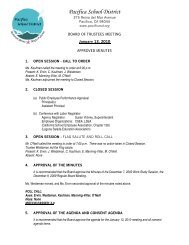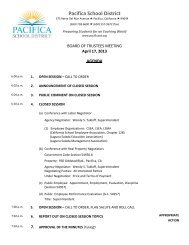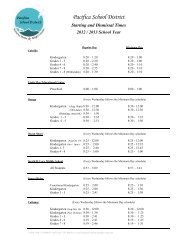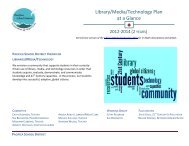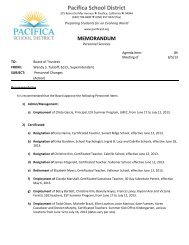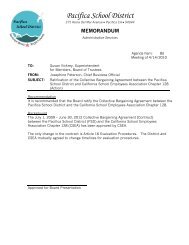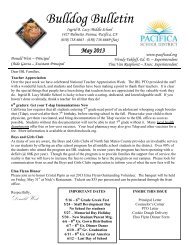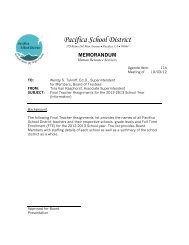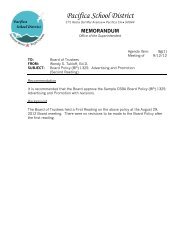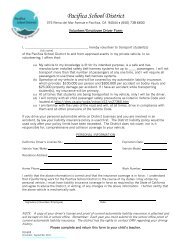Minutes - Pacifica School District
Minutes - Pacifica School District
Minutes - Pacifica School District
Create successful ePaper yourself
Turn your PDF publications into a flip-book with our unique Google optimized e-Paper software.
BOARD MEMBERS PRESENT:<br />
Ms. Karen Ervin, President<br />
Mr. Michael O’Neill<br />
Ms. Eileen-Manning-Villar<br />
Ms. Cynthia Kaufman<br />
Ms. Joan Weideman<br />
STAFF MEMBERS PRESENT:<br />
Ms. Susan Vickrey, Superintendent<br />
Ms. Kitty Mindel, Assistant Superintendent<br />
Ms. Josie Peterson, Chief Business Official<br />
Ms. Flo Derby, Board Scribe<br />
1. OPEN SESSION - CALL TO ORDER<br />
<strong>Pacifica</strong> <strong>School</strong> <strong>District</strong><br />
375 Reina del Mar Avenue<br />
<strong>Pacifica</strong>, CA 94044<br />
www.pacificasd.org<br />
BOARD OF TRUSTEES MEETING<br />
APPROVED MINUTES<br />
FEBRUARY 25, 2009<br />
Board President Ervin called the meeting to order at 6:00 pm, stating Board members Weideman, Kaufman, Manning-Villar and O’Neill were<br />
all present. Ms. Ervin adjourned the meeting to Closed Session at 6:01 pm.<br />
2. CLOSED SESSION<br />
(a) Conference with Legal Counsel – Pending Litigation<br />
Jenkins, Goodman, Neuman & Hamilton, L.L.P.<br />
(b) Conference with Labor Negotiator<br />
Agency Negotiator: Susan Vickrey, Superintendent<br />
Employee Organizations: CSEA, LSEA<br />
(California <strong>School</strong> Employee Association, Chapter 128)<br />
(Laguna Salada Education Association)<br />
3. OPEN SESSION - FLAG SALUTE AND ROLL CALL<br />
Ms. Ervin called the meeting to order at 7:10 pm, stating the Board met in Closed Session. There was no action taken. Ms. Kaufman led the<br />
Pledge of Allegiance. All Board members were present.<br />
4. APPROVAL OF THE MINUTES<br />
It is recommended that the Board approve the <strong>Minutes</strong> of the February 4, 2009 Regular Board Meeting. Mr. O’Neill, seconded by Ms.<br />
Weideman, made a motion, to approve the <strong>Minutes</strong> as presented.<br />
ROLL CALL:<br />
Ayes: Weideman, Kaufman, Manning-Villar, O’Neill and Ervin<br />
Noes: None<br />
MOTION PASSED: 5-0<br />
5. APPROVAL OF THE AGENDA AND CONSENT AGENDA<br />
It is recommended that the Board approve the agenda for the February 25, 2009 meeting and all consent agenda items. Ms. Ervin
MINUTES OF REGULAR BOARD MEETING February 25, 2009 Page 2<br />
asked that Item 8(f) be removed from the Agenda.<br />
All items on the consent agenda will be approved with one motion, which is not debatable and which requires a unanimous vote for<br />
passage. If any member of the Board, the Superintendent, or the public so requests, any item shall be removed from this section and<br />
placed in the regular order of business following approval of the consent agenda.<br />
(a) Agenda of the February 25th , 2009 meeting<br />
(b) Consideration of Acceptance of Warrants<br />
It is recommended that the Board approve the attached commercial warrants for the period of 1/23/09 through 2/06/09 totaling<br />
$255,584.09.<br />
(c) Personnel<br />
It is recommended that the Board approve the Personnel items as presented.<br />
1) Management:<br />
2) Certificated:<br />
3) Classified:<br />
Retirement of James Rogers, Principal, Ortega Elementary <strong>School</strong>, effective June 30, 2009.<br />
a. Karen Stevenson, Classroom Teacher, Sunset Ridge <strong>School</strong>, returning from Maternity/Child Rearing Leave, for the 2009-2010 <strong>School</strong> Year.<br />
b. Resignation of Anthony Comisso, Classroom Teacher, Sunset Ridge <strong>School</strong>, effective June 12, 2009.<br />
c. Resignation of Jean Chiamonte, Substitute Teacher, <strong>District</strong> Office, effective January 29, 2009.<br />
d. Termination of Inactive Substitute Teacher, Cleo Borac, <strong>District</strong> Office, effective January 30, 2009.<br />
e. Resignation of Bobby Singh, Classroom Teacher, Ingrid B. Lacy Middle <strong>School</strong>, effective June 12, 2009.<br />
f. Retirement of the following Classroom Teachers, effective June 13, 2009:<br />
Maxine Bailey 8 th Grade Language/Arts Ingrid B. Lacy<br />
Kathleen Noonan 1 st Grade Sunset Ridge<br />
Rita Garcia Resource Specialist Ortega<br />
a. Retirement of Carol Crowell, SPC/Credential Technician, <strong>District</strong> Office-Certificated Personnel, effective June 30, 2009.<br />
b. Employment of Emi Arai, Instructional Aide – 4 hours (Probationary Status), Classified Salary Schedule A for Appropriate Position Range, Linda Mar<br />
Educational Center, effective February 11, 2009.<br />
c. Employment of Angela Gibbs, Instructional Aide – 2 hours (Probationary Status), Classified Salary Schedule A for Appropriate Position Range,<br />
Ingrid B. Lacy Middle <strong>School</strong>, effective February 11, 2009.<br />
(d) Service and Consultant Contract Approvals<br />
It is recommended that the Board approve the Service and Consultant contracts as presented by staff.<br />
Consultant/Contractor Dollar Amount Term of Contract<br />
1. Sound & Signal, Inc. $8,187.00 February 2, 2009 through March 2, 2009<br />
Livermore, CA 94551-7216<br />
<strong>District</strong>: Propose to install a new sound system in the multi-purpose room. This system will include a new wall mounted amplifier, that<br />
the <strong>District</strong> will be responsible for mounting along with providing power to the new unit. Sound & Signal will install 1 Auxiliary<br />
input and 2 Apogee Speaker mounted on either side of the stage. A total of 4 microphone outlets will be installed once the<br />
<strong>District</strong> mounts the stage floor box and provides the required fire pathway for the stage microphones.<br />
Contract #: 001735<br />
Fund/Site: Building Fund/Vallemar<br />
Budget Account Code: 21-9011-0-0000-8500-6274-008-0830<br />
____________________________________________________________________________
MINUTES OF REGULAR BOARD MEETING February 25, 2009 Page 3<br />
(e) Overnight Field Trip Approvals (AR 6153)<br />
It is recommended that the Board approve the overnight field trips as presented.<br />
(f) Extension of Agreement between Susan Vickrey and the <strong>Pacifica</strong> <strong>School</strong> <strong>District</strong><br />
It is recommended that the Board approve the Agreement between Susan Vickrey and the <strong>Pacifica</strong> <strong>School</strong> <strong>District</strong> to extend<br />
Superintendent Services until July 31, 2010.<br />
(g) <strong>School</strong> Calendar for the 2009-10 <strong>School</strong> Year<br />
It is recommended that the Board approve the <strong>School</strong> Calendar for the 2009-2010 <strong>School</strong> Year.<br />
Ms. Weideman made a motion, seconded by Ms. Kaufman, to approve the Agenda and the Consent Calendar, with Item 8(f) removed<br />
ROLL CALL:<br />
Ayes: Weideman, Kaufman, Manning-Villar, O’Neill and Ervin<br />
Noes: None<br />
MOTION PASSED: 5-0<br />
6. COMMUNICATIONS<br />
This portion of the agenda is available to the public to address the Board on any issue that is not on the agenda. The maximum time<br />
allowed for any speaker is three minutes.<br />
(a) LSEA (Laguna Salada Education Association) None<br />
(b) CSEA (Classified <strong>School</strong> Employees Association) None<br />
(c) People Wishing to Address the Board<br />
Ms. Kalimah Salahuddin advised the Board that previous suggestions that parents write letter to their legislators has resulted in some<br />
parents getting together with a few Board members and started the “Saving <strong>Pacifica</strong> <strong>School</strong>s Political Action Committee.” She invited<br />
anyone to join.<br />
(d) Correspondence<br />
Ms. Weideman responded to an e-mail she had received about the enrollment policy of the <strong>District</strong>. She had been asked to personally recuse<br />
herself from the decision-making process as a conflict of interest. She responded that the decisions made by the Board members affect their<br />
own children personally but no more than or less than anyone else’s children. For that reason she will not recuse herself because her child will<br />
be equally impacted when times are good and when times are bad. She believes her voice does not personally benefit her child in any way<br />
and she will continue to serve the community as an advocate for all the children throughout the <strong>District</strong>.<br />
Ms. Ervin commented that as all Board members are parents, they truly strive to do what is best for all the children. It is a consequence of<br />
having parents that want to be Board members. Most of the decisions that they make will affect most of the kids going to school. They all try to<br />
do what is right for all the children as a whole.<br />
(e) Board/Superintendent Communications<br />
Ms. Weideman reported she had attended the Enrollment Work Study. She announced the <strong>District</strong> Book Sale on April 25th at two locations:<br />
Linda Mar Shopping Center and the Fairmont Shopping Center. It is supported by First National Bank, both <strong>Pacifica</strong> Starbuck’s and the<br />
<strong>District</strong>. She attended the Kent Awards Committee and made a site visit at Canada College to Center for Teacher Efficacy, a collaboration<br />
between Jefferson Union High <strong>School</strong> <strong>District</strong>, Sequoia High <strong>School</strong> <strong>District</strong> and San Mateo High <strong>School</strong> <strong>District</strong> in conjunction with Canada<br />
College and San Francisco State University. They have created curriculums to support high school teachers in terms of teaching subjects to a<br />
diverse population. She commented on the program and was impressed that teachers are on wait-lists to get into these classes. She also<br />
attended a seminar on getting her own credential. There will be a Jefferson Union High <strong>School</strong> <strong>District</strong>/<strong>Pacifica</strong> <strong>School</strong> <strong>District</strong> Joint<br />
Articulation Meeting on March 2, 2009.<br />
Ms. Kaufman attended the Enrollment Work Study. She also dropped by the Ingrid B. Lacy Chocolate Fest and the <strong>Pacifica</strong> <strong>School</strong> Foundation<br />
Kickoff meeting. She went along to Sacramento to meet with Jerry Hill. She said a high point for her was when Kalimah’s daughter Amira<br />
read her letter to Assembly member Hill and for Channel 10 Sacramento. Jerry Hill was impressed with the children.<br />
Ms. Manning-Villar also went to Assembly member Hill’s office, along with about 35 others, including 20 students. They had a tour of the<br />
Assembly Chamber and did a little rally out front with the kids. Senator Leland Yee had to cancel their meeting the next day because the<br />
Legislature had met through the night settling the budget after 48 hours. They did, however, meet with an aide and got some ideas on how to
MINUTES OF REGULAR BOARD MEETING February 25, 2009 Page 4<br />
get their voices out there. She attended the Enrollment Work Study, Vallemar <strong>School</strong>’s Jump Rope for Heart (students raised $14,000 for the<br />
American Heart Association), a lecture on Proposition 13, the <strong>Pacifica</strong> Democrats, and the <strong>Pacifica</strong> <strong>School</strong> <strong>District</strong>/Laguna Salada Education<br />
Association workshop on good faith bargaining.<br />
Mr. O’Neill was in charge of the Games at the Ingrid B. Lacy Chocolate Fest (about $14,000 raised). He said the most popular was the dunk<br />
tank for teachers. He went to the <strong>School</strong> Lottery Work Study and a San Mateo County <strong>School</strong> Board Association discussion about bullying. He<br />
added that four attended the California Teachers Association meeting in Foster City earlier this month.<br />
Ms. Ervin attended the <strong>School</strong> Lottery Work Study and she and Mr. O’Neill attended the Bullying and Conflict Resolution discussion provided by<br />
the San Mateo County <strong>School</strong> Board Association (“SMCSBA”). There are programs out there that are available to address these issues when<br />
the <strong>District</strong> is ready. She went to the meeting for the <strong>Pacifica</strong> <strong>School</strong> Foundation and the Chocolate Fest.<br />
Superintendent Vickrey reported on correspondence from Tracy Gilbert, a supervisor for the <strong>Pacifica</strong> Parks Beaches & Recreation Department,<br />
thanking and acknowledging the work of the <strong>District</strong>’s Director of Maintenance and staff for their help installing kitchen areas at the daycare<br />
center at Sunset Ridge. She also had a letter from the CSEA (Classified Union) Executive Board stating our <strong>District</strong> has been selected to<br />
participate in a program called “Appreciating Classified Employees”, a shadowing program where members of the Board and the administrators<br />
will shadow a classified employee for as little as an hour or some other period of time. They have asked that we consider it for the week of May<br />
17th . The Board will be asked to make a decision at the March 18th meeting.<br />
Ms. Weideman said she had received an e-mail about the Future of Education in California, which is being presented on March 2 in Silicon<br />
Valley Education Foundation. There is also “Budget Crisis: Saving the Classroom” on March 17th , speaker Jack O’Connell, in San Jose. The<br />
CTA is having a Legislative Breakfast on May 9th .<br />
Ms. Manning-Villar reported that Vallemar <strong>School</strong> will host a Pancake Breakfast on March 8th . “Read Aloud Day” will happen on March 6th at<br />
Ortega <strong>School</strong> and March 27th at Sunset Ridge <strong>School</strong>. Senator Yee, Assembly member Hill and Gene Mullin will be participating, along with<br />
local dignitaries. .<br />
(f) Board Committee Reports – based upon written reports<br />
7. PRESENTATIONS<br />
(a) Library Foundation – Eric Ruchames and Jim Crow<br />
Mr. Eric Ruchames, Vice President of the <strong>Pacifica</strong> Library Foundation (“PLF”), stated the PLF is working in the community to identify the needs<br />
and how to meet them with a new state-of-the-art library for the 21st century. Of the two small libraries in town, neither is adequate to serve this<br />
community. The questions are how to move forward and how to reach these goals. People always ask how much it will cost and where will it<br />
be located. He described a different approach that asks the question: What does this community want? Then they can answer the other<br />
questions. “<strong>Pacifica</strong> Connected” is the outreach program, a three-year plan, co-chaired by Suzan Getchell-Wallace. He introduced Jim Crow<br />
who gave a historical report of the foundation and the school district. He presented the background on the cooperative relationship that has<br />
already been established between the <strong>School</strong> <strong>District</strong> and the Foundation. Mr. Crow talked about what may be possible for a new library.<br />
Property was generally discussed, along with what types of services might be accommodated. Mr. O’Neill had been a part of the site analysis<br />
committee. Possible shared use was discussed. Mr. O’Neill had also participated in the “<strong>Pacifica</strong> Connected” steering committee. He has<br />
become a very valuable participant. They have now launched the plan for outreach and involvement of the community in the planning process.<br />
Mr. Crow left some flyers describing the “<strong>Pacifica</strong> Connected” program for the public. He stated the Foundation looks forward to a continuing<br />
relationship of cooperation with the <strong>District</strong>.<br />
Mr. Ruchames said the next question is how can we work better together to move forward and how can we involve the education community<br />
which is a critical component , along with the environmental and business communities and other groups in town, to make this process a<br />
success. What they want for a library will drive the success of the program. He suggested that the PLF would like to work with the <strong>District</strong> on<br />
their partnership, reach out to Jefferson Union High <strong>School</strong> <strong>District</strong> as well, on the issues that are of primary concern to the education<br />
community. He asked the Board to consider appointing a liaison committee from the Board, perhaps a couple of Board members and staff,<br />
who could meet with the Foundation, and perhaps include the Education Foundation, to meet on whatever basis is most productive, and talk<br />
about the issues facing the community together. We have limited resources and need to be sure we are not going at crossed purposes. He<br />
hopes that when it is time for sector meetings involving education, there could be access to using schools. He knows from conversations with<br />
Ms. Vickrey that the Board supports this. He believes it is imperative to moving forward with a positive attitude.<br />
Ms. Ervin asked how often the Foundation currently meets. Mr. Ruchames said the Board meets once a month and more frequently. The<br />
Foundation is a volunteer group of <strong>Pacifica</strong> residents. Suzan Getchell-Wallace and Stephanie Vinces, who are the co-chairs of “<strong>Pacifica</strong><br />
Connected”, meet very frequently. He envisioned monthly, quarterly or as needed when issues arise. Mr. O’Neill suggested it could be<br />
discussed at the March 11th meeting, with the Strategic Plan. He commented that having been involved with this for a while, the word Library is<br />
almost a misnomer. These facilities now are more Learning Centers. He visited the new one in Phoenix and described his experience there.<br />
New libraries are alive with many different rooms and a multitude of activities for people. They are exciting places to be.<br />
The Board thanked the Library Foundation for their presentation.
MINUTES OF REGULAR BOARD MEETING February 25, 2009 Page 5<br />
8. DISTRICT BUSINESS<br />
Agenda item 8(m) is intentionally heard first.<br />
(m) Approval of One-Year Contract for the 2009-10 <strong>School</strong> Year with Sodexo for Child Nutrition Management Consultant Services<br />
It is recommended that the Board approve a one-year contract for the 2009-10 school year with Sodexo to provide a full-time onsite<br />
consultant and additional corporation support for our Child Nutrition Program.<br />
Mr. O’Neill moved to approve the contract with Sodexo for Child Nutrition Management Consultant Services for 2009-10; seconded by Ms.<br />
Weideman.<br />
Ms. Peterson summarized the staff report. Previous to Sodexo having been awarded their first contract, the <strong>District</strong> had been running a deficit<br />
for the Food Services Program for a number of years of about $30,000 per year. The General Fund was owed about $130,000 at the time.<br />
With the help of Sodexo, the <strong>District</strong> is now running a profitable program, breaking even and paying back the General Fund. The <strong>District</strong> is up<br />
to speed on the Wellness Policy and State requirements. They have also helped during this uncertain economy with continuity of quality. Two<br />
contracts were received. Sodexo is proposing a break-even proposal again. Staff recommends approval in order to maintain the costs and to<br />
avoid start-up costs for a new provider.<br />
Ms. Kaufman commented that she appreciated the report and felt it important to maintain since it is a very well managed program. She did<br />
express concerns about the nutrition of the food and the extent to which we rely on processed food. She wished the program could move in the<br />
direction of having more healthy options. Ms. Peterson said staff can look at modifications and the cost can be analyzed. The annual report<br />
on the Food Services program will be presented to the Board in March.<br />
ROLL CALL:<br />
Ayes: Weideman, Kaufman, Manning-Villar, O’Neill and Ervin<br />
Noes: None<br />
MOTION PASSED: 5-0<br />
(a) State Budget Update<br />
Ms. Vickrey explained that the budget the Board had been discussing for several weeks was a proposal from the Governor. Once it actually<br />
passed, it is quite different from the proposal we have discussed so far. The good news is that the <strong>District</strong>’s budget cuts are actually somewhat<br />
less than the Governor’s proposal. The bad news is that in many ways, our lives will be more difficult. Ms. Peterson will summarize the<br />
changes.<br />
Ms. Peterson apologized to the Board for not getting this information to them ahead of the meeting tonight. We will continue to provide<br />
information as it becomes available. Ms. Vickrey said Josie had attended a workshop yesterday from 2:00-5:00 pm to pick up what we know<br />
now. It has been a rapidly changing situation.<br />
Ms. Peterson went over the Budget Development Calendar, stating it was confusing this year. In a typical year, the <strong>District</strong> starts planning for<br />
the budget in January for the following fiscal year, July 1-June 30. Typically in January the Governor will have a proposal for the budget for the<br />
next fiscal year. We also file interim reports in March that reflect where we stand based on that proposal and going two years out. There is<br />
also the March 15th deadline for certificated layoffs. The State’s May revision is typical because they know when their tax receipts are arriving<br />
in April and the Governor does the May revision. They are supposed to adopt the State budget by June. <strong>School</strong> <strong>District</strong>s are also required to<br />
adopt their budgets by June based on the information available from the State.<br />
Ms. Peterson commented the problem this year is that the <strong>District</strong> is still looking at the budget for 2008-09, July 1 , 2008 through June 30, 2009.<br />
We are almost into March and the State is still making changes to the current year budget. The State did not adopt its budget until September.<br />
Less than a month later, the Governor called a Special Session and there has been a series of such sessions on this year’s budget where they<br />
have gone back and forth. Three weeks ago, staff presented a budget to the Board based on the Governor’s January proposal, which now has<br />
drastically changed. Tonight the presentation is the changes to the current fiscal year and what the State is proposing for next fiscal year. It is<br />
a two-year package.<br />
Ms. Ervin inquired if there has been a two-year package before. Ms. Peterson stated there has not been in her experience but there have been<br />
mid-year cuts, but the cuts have been known earlier, such as in December. We have been able to deal with those a little better, but after the<br />
year has started, it is hard to cut anything for the <strong>District</strong>’s budget. There will be a May revision, but there will be a special election in May so<br />
the May revision is being put off until after the election. Mr. O’Neill said the May revisions are based on the tax receipts received April 15th .<br />
They are already looking for a $6- to $8-billion deficit in the May revisions. The May revision will be later than normal.<br />
Ms. Peterson said that after a long delay, the Legislature has finally passed a budget, a two-year package for 2008-2009 and 2009-2010. The<br />
State’s financial condition remains critical. The budget is a moving target and will change with the May revision. Education is experiencing
MINUTES OF REGULAR BOARD MEETING February 25, 2009 Page 6<br />
historical mid-year and budget reductions. If revenue continues to drop, there will be additional reductions for 2009-2010. She used a chart to<br />
exemplify the history of the State’s budget deficit. In July 2007, they knew they had a $6-billion deficit. In December, it was almost $42-billion.<br />
You can see how quickly and how drastically the situation has changed. It is called the “Budget Correction Package”, a two-year budget.<br />
There are mid-year reductions and funding deferrals. In 2009-2010, there will be additional reductions and deferrals. There are several<br />
propositions built into the May 19th special election that are intermingled. One is the lottery proposal. If that does not pass, that represents $5billion<br />
that the State is counting on for this budget. If these proposals fail, we will be back doing this again with another very different situation.<br />
Ms. Peterson outlined the changes for 2008-09 is that there is a reduction in Prop. 98 funding by $6-billion and it is a mix of program<br />
reductions, deferrals and redesignation of funds. The total is $1.9-billion for program reduction. There was a .68% COLA this year but there is<br />
no COLA. The huge cut to the revenue limit we had discussed three weeks ago (the amount of money received per student), now shows<br />
splitting the cuts between the revenue limits and between State categoricals. The revenue limit is about $160 per student and they are cutting<br />
our categoricals, which is our <strong>School</strong> Improvement Program, GATE and those types of funds, by 15% across the board this year.<br />
The main thing is that they have removed many of the program flexibilities that were built into our budget. One of the big discussions was<br />
about class size reduction. The categoricals have been divided into three tiers:<br />
Tier One: No reduction and no flexibility.<br />
Child Development; child nutrition; economic impact aid; K-3 class size reduction; Proposition 49 after school programs; special education;<br />
Quality Education Investment Act; home-to-school transportation<br />
Tier Two: 15% reduction and no flexibility.<br />
Adults in correctional facilities; partnership academies; apprenticeship programs; state testing, English language acquisition program;<br />
agriculture-vocational education; foster youth; charter school facilities grants; K-12 high speed network; multi-track YRE<br />
Tier Three:<br />
15% reduction but total flexibility to shift funding to any other educational purpose (including to unrestricted General Fund); all remaining K-12<br />
Proposition 98 categorical programs; tiers and associated flexibility apply to State categorical programs only, no Federal.<br />
Ms. Mindel gave the example of the Math Adoption due for our <strong>District</strong>. In that situation there was talk about giving a waiver to districts to<br />
extend the necessary time to be able to have it in place. Now there is reduction in funds but the Math Adoption must be in place for 2009-2010<br />
school year. Ms. Vickrey noted that it doesn’t have to be in place for 2009-2010, but you have to have both it and the Language Arts adoption<br />
in place by 2010-2011. We cannot take the instructional materials money and spend it elsewhere because if we do so, we will not have the<br />
adoptions in place by the time requirement.<br />
Ms. Ervin commented on combination classes and increasing class sizes to potentially lay off seven teachers to save money, but that is no<br />
longer an option.<br />
Ms. Peterson continued that the flexibilities in categoricals are projected through 2012-2013 school year. Regarding class size reduction, the<br />
flexibility is gone to be able to add a student to the class and still keep the funding. There were penalties in place where you could add a child<br />
to the class and pay a penalty. They have changed the numbers so that now you could go up to 25 kids in a class and pay a penalty. However,<br />
the rules and limitations are so strict that it would be almost impossible. You would only get the funding on the 20 kids and paying a penalty of<br />
20%. There is the risk that if you do it in one class, you could lose the funding for the whole grade level. For the <strong>District</strong> to increase class size<br />
in K-3 to 25, we would only have $150,000 in savings. It would not work at all for us under this scenario.<br />
Ms. Peterson said that regarding Instructional Materials, there is some flexibility to put it off for one year. However, all the requirements in the<br />
Williams Settlement have to be met. If the <strong>District</strong> postpones the math adoption for one year, there will be two adoptions to purchase in the<br />
same year. State instructional materials estimated funding is $58 per student in 2008-09 and $55 per student in 2009-2010. Math costs are<br />
$78 per student; Language Arts is $125 per student. It will be difficult to purchase the texts with the current funding.<br />
Ms. Peterson explained Sweep Ups (Prior Year Categorical Balances). In the Tier Three, the <strong>District</strong> can actually move one pocket of money<br />
to another, such as from the <strong>School</strong> Improvement Program to the GATE program. These are the programs that are excluded: economic impact<br />
aid; targeted instructional improvement grants; instructional materials; special education; Quality Education Investment Act; California high<br />
school exit exam; supplemental instruction; and home-to-school transportation. If you move funds, that is a one-time fix, only helping in the<br />
current year. The other flexibility is the Routine Restricted Maintenance Account where we are required by law to take 3% of the General Fund<br />
budgets for current year and until 2012-13. We would be able to reduce that percentage to 1%. That would reduce the upkeep of the buildings<br />
and the maintenance department salaries. Deferred Maintenance allows flexibility to defer the set aside for this current year. However, this is<br />
the base year for a future match. So by not setting it aside this year ($130,000), the <strong>District</strong> would lose the money in 2009-2010. Not putting<br />
this money aside this year could end up costing the <strong>District</strong> hundreds of thousands of dollars over the next three or four years.<br />
Ms. Peterson learned that regarding After <strong>School</strong> Tutoring, if we had not continued our program this year, we would not have the base of<br />
funding to continue that program in the years going forward. There are several items written into the budget proposal like that and the <strong>District</strong><br />
has to be very careful that if we cut it this year, we could be as risk of losing it in future years.
MINUTES OF REGULAR BOARD MEETING February 25, 2009 Page 7<br />
The State Budget reflects no changes to several items. <strong>District</strong> will still be required to meet minimum statutory reserves as of July 1, 2009<br />
(3%). The minimum number of instructional days and minutes remain (180 days). There is no suspension of mandates as proposed by the<br />
Governor. <strong>District</strong>s are recommended to continue processing claims and maintain records. There is no funding for the Special Education<br />
Behavioral Intervention Plan. Mr. O’Neill asked if the <strong>District</strong> would still have to fund it. Ms. Peterson stated we have been doing the work but<br />
not getting reimbursed.<br />
Ms. Peterson said a major complication in the budget is state Deferrals. The State pays us every month for the money that they owe the<br />
<strong>District</strong> per student. Several years ago the State started delaying the June payment until July. They are adding more deferrals to the list. Now<br />
the money they owe us for February for class size reduction (about $1-million) and for our revenue per student, they are not going to pay us for<br />
February until July. They are also saying in July, they will not pay what they owe for July until October. The money they owe in August they<br />
will not pay until October. They will increase the amount of money they were not paying in June, until July. They are shifting all the money they<br />
owe the <strong>District</strong> to farther and farther out. This creates a cash flow problem for the <strong>District</strong>. We will be fine making payroll through June. We<br />
have cut back some purchases and monitoring our cash flow every month. Other districts are doing the same. They are using their TRAN.<br />
The County did advise districts that as long as they have money in all of your funds collectively, you can go negative in one area. In June,<br />
however, it has to all be positive. For example, the Building Fund has $3.8-million. As long as we have the money in all our funds, we could go<br />
negative in one fund to continue operating as a school district. Mr. O’Neill confirmed the TRAN has to be settled and paid June 30. Ms.<br />
Peterson said the <strong>District</strong> has to pay the TRAN and depending on cash flow, we might have to do a resolution in June asking the Board to<br />
authorize a short-term temporary loan from one fund to another. Then in July or August we would pay it back immediately upon receipt of the<br />
money from the State. There would be a new TRAN on July 1. The TRAN would have to be used from July to September to get through until<br />
October.<br />
Mr. O’Neill asked for a ballpark estimate of all the monthly deferrals the State has done over the past several years and if the State is about<br />
seven to eight months behind. Ms. Peterson said that prior to this year, it has only been the June payments to July. Now we are approaching<br />
from July to October. Soon that will be six months behind.<br />
Ms. Peterson summarized the impact for the current fiscal year, 2008-09. The State is cutting our budget this year by $600,000. The amount<br />
we receive per student for this year, which has already been spent, is reduced by $600,000, in addition to deferring our revenue limit and class<br />
size reduction payment. We will have a continual cash flow problem, and in addition, we will have $600,000 in budget cuts. As to Tier One,<br />
Two and Three cuts, our programs face 15% reduction. The biggest hit will be to the <strong>School</strong> Improvement Program (almost $100,000), which<br />
has already been given to the school sites. She enumerated the list. The total is near $200,000 for this year. These cuts are in addition to the<br />
$600,000 mentioned above.<br />
Ms. Peterson summarized the proposed State budget for 2009-10. The typical COLA of 5.02% is not funded. The revenue limit per student will<br />
be further reduced by $45 per student. The categoricals will be cut by 4%. There will be continued deferral of the April 2010 revenue limit and<br />
class size reduction funding until July 2010. The budget also eliminates matching requirement for the deferred maintenance program. The<br />
impact of the cuts of the <strong>School</strong> <strong>District</strong> would be revenue limit reduction of $150,000 and 5% reduction in categoricals of $55,000.<br />
The impact of the State Budget to the <strong>Pacifica</strong> <strong>School</strong> <strong>District</strong> is $800,000 for 2008-09 and $200,000 for 2009-2010 for a total of $1-million. This<br />
is conservative because when the May Revision comes out, it may be quite different.<br />
Ms. Peterson then discussed the $1.8-million that has been cut by the <strong>District</strong> over the last seven years. The <strong>District</strong> is now looking at cutting<br />
another $1-million this year. The <strong>District</strong> has shown fiscal accountability for the $65-million facilities modernization program, which was done<br />
on time and on budget. There has been a commitment to the public that those buildings will be maintained. An independent citizen oversight<br />
committee has reviewed the expenditures from the parcel tax and determined the expenditures matched the parcel tax ballot language.<br />
Ms. Vickrey apologized to the Board for the vast amount of information being presented tonight. Based on the time the information was<br />
received, there was no option. The <strong>District</strong>’s challenge is to cut $1-million between now and this time next year. There are some opportunities<br />
and options. The parcel tax money is $1-million. However, the full $1-million cut cannot come from the parcel tax. That means there are going<br />
to be cuts. Before the Board can decide where to cut money, we should look at where we stand with money. The <strong>District</strong> spends about 3% of<br />
its money on utilities, 9% goes to certificated Administration, 19% to Classified (school secretaries, payroll clerk, purchasing agents,<br />
maintenance, etc.), 15% on categoricals (pencils, paper, texts, globes, etc.), and about 54% on teachers salaries. We have cut $1.8-million;<br />
there is not much excess. Ms. Vickrey specified where the parcel tax had been spent this year. The Board could make changes to roughly<br />
$800,000 if they opted to do so from the parcel tax money. She pointed out the base year requirements for grants in future years, for example<br />
for the After <strong>School</strong> Tutoring/Homework program. If the <strong>District</strong> had chosen not to fund this for 2008-09, there would be no base year for future<br />
funding.<br />
Ms. Vickrey stated the $1.8-million cuts being discussed are from the State money. She spoke about grant fund loss. Some years the <strong>District</strong><br />
has run on as much as about $750,000 in grant money. There are two grants pending that we are waiting for word from the federal<br />
government and one from Silicon Valley Math Initiative. Unless we get one of those, there is no competitive grant money for next year. Money<br />
that we have for people like our math coaches has always been grant money. We have one application that is already in and one that is due<br />
next week to be presented on March 13, 2009. We are hoping we will receive money. If not, these represent additional cuts.<br />
Ms. Vickrey said that looking at additional cuts, the Board can look at cutting Administration. However, it has been cut for a long time and the
MINUTES OF REGULAR BOARD MEETING February 25, 2009 Page 8<br />
<strong>District</strong> is running thin. The <strong>District</strong> could make cuts in Buildings and Grounds. We can cut Classified staff (custodians and secretaries).<br />
Anything involving Certificated personnel has to be negotiated. Using interest-based bargaining, we would decide how much we would need to<br />
make certificated cuts and then go to the bargaining unit with a number, and ask the unit to help come up with ideas as to where to cut. Of<br />
Administration, we can cut one administrator. Reductions in the confidential staff at the <strong>District</strong> Office can be made. (There may be some<br />
retirements.) Buildings and Grounds and Other can be cut by not watering the grounds, eliminating the Ingrid B. Lacy counselor, taking Board<br />
packets completely on-line, cutting the CSBA conference. We could use some of the one-time categorical money if flexibility is offered. These<br />
are decisions the Board can make without negotiating with bargaining units.<br />
Under Classified Personnel, the <strong>District</strong> could eliminate 1 groundskeeper and a custodian. However, buildings do not clean themselves. So it<br />
would mean there will be less service and buildings get cleaned less often. Ms. Vickrey felt the <strong>District</strong> is already bare bones and we have<br />
major assets to maintain. We can eliminate crossing guards. Eliminating the summer work crew might be a practical one. Ms. Peterson<br />
explained the summer work crew by stating that we hire four or five extra custodians to go around to every school and clean out every room,<br />
strip the floors and put layers of new wax. They move teachers and there is a great deal of work during the summer for that crew. The regular<br />
custodians would have to pick up as much of the work as possible, but not everything would get done.<br />
Ms. Vickrey then presented some ideas involving Certificated Personnel that might be considered by a negotiating team. Since we use Interest<br />
Based Bargaining, we would then add suggestions by the units to negotiate. (Presented as examples only)<br />
• Pay cut to all employees (5%) $655,000<br />
• 4th – 8th grade prep period eliminated $ 88,000<br />
• 6 th – 8 th grade prep period eliminated (IBL) $ 200,000<br />
• Cap employee benefits at 2 party $200,000<br />
• Increase PE class size at IBL (192 contacts) $ 88,000<br />
• Freeze step and column $120,000<br />
• Retirement incentive<br />
• No new Willie Brown<br />
Ms. Vickrey noted to the Board that these are only ideas and may be good ideas or not. Staff felt they should bring some suggestions to the<br />
Board. Some things that may have seemed like great ideas three weeks ago are not even on the list now. That is due to the way the<br />
regulations are falling down. We have to cut less money, but in some way we were better off with the other proposal, in that it provided much<br />
more flexibility as to how to address the issues. We have some challenges over the next few weeks. That is assuming the State revenues<br />
actually come in as projected. Regarding the Stimulus Package, Ms. Vickrey noted <strong>Pacifica</strong> will get $749,000 for Special Education. This<br />
payment will go through the State. The State is able to use it for their own Special Education programs if necessary. Therefore, the State has<br />
decided that since the Federal government is giving us $749,000 for Special Education, they will not give us the $749,000 in Special Education<br />
money they were going to give us. The County is telling us we cannot put the money in our Second Interim Budget. All things are subject to<br />
change. Nobody knows for sure what is going to happen.<br />
Ms. Ervin stated that there are items that are going to be negotiable with the unions, as well as items that will not need to be negotiated. She<br />
asked if the numbers could be presented such as (1) non-negotiable items; (2) negotiable items; (3) other ideas that anyone would like to ask<br />
questions and give direction to staff.<br />
Ms. Kaufman expressed that she likes to see spreadsheets. She would like to see where the Measure N money comes in. For example, there<br />
is $350,000 bonus given to the teachers this year, which we will not be giving to them next year. Ms. Peterson can prepare a new spreadsheet.<br />
Ms. Vickrey advised the Board there is no expectation for decisions to be made tonight. The core issue is going to be how much of the Parcel<br />
Tax money would the Board want to use and how would the Board like to use it. There are repercussions for all cuts. Staff is asking for some<br />
idea from the Board as to what staff should prepare for the next presentation.<br />
The Board discussed and asked questions of staff in some detail as to various processes and ramifications that can be anticipated to occur as<br />
a result of possible budget adjustments. Staff asked staff to focus on cutting $1-million per year. Mr. O’Neill stated that since some funding<br />
(approximately $600,000+) has already been delegated from the Parcel Tax proceeds for 2008-09, the Board has $1.3-million available for the<br />
two year periods. Ms. Kaufman thought a spreadsheet would be helpful. Ms. Peterson will create one and e-mail it to the Board.<br />
Discussion followed on the BTSA program, coaching, multi-year projection, and the structural deficit and cash flow issues. Ms. Vickrey said<br />
there will be a better picture as to the actual situation concerning classroom teachers and those who are presently on leave by the next<br />
meeting. Mr. O’Neill asked the ultimate goal of tonight’s process.<br />
Ms. Ervin stated tonight’s item is an information item largely about a budget update from the State. She thought it was a good time to ask<br />
questions to help is more prepared for the next meeting. Ms. Weideman asked about tracking programs, as well as funding. Mr. O’Neill asked
MINUTES OF REGULAR BOARD MEETING February 25, 2009 Page 9<br />
for figures on what the BTSA program would look like with only second year teachers participating and reducing the staff time to accommodate<br />
a smaller number of participants in the event there are no first year teachers involved.<br />
Ms. Weideman said that the coaching to her represents a critical piece for having equity in the schools. Through the implementation of the<br />
Writer’s Workshop program, the achievement gap is closing. It has been a successful program and she is concerned if it were to be cut. This<br />
type of staff development and on-going training is philosophically important to her. Ms. Ervin is interested in knowing how often people see the<br />
literacy coach and the math coach. She wants to see if teachers still need these coaches and are utilizing their services. She knows the<br />
benefits have been noticeable in scores, and most of the teachers have had the benefit of these services for a number of years now. Mr.<br />
O’Neill would like to keep both coaches, but he would almost like to see a hybrid of the two. He feels the math coach may be more important<br />
because math can be more intimidating for a person to teach than might be the literacy program. Ms. Mindel reported the literacy coach this<br />
year moved more into working with the 6th-8th grade language arts teachers, working particularly at comprehension. It was expanded beyond<br />
Writer’s Workshop this year for the first time. Mr. O’Neill asked if there is data available to see if there is benefit to continue working with the 6th- 8th teachers, since the students go from there to the high school exit exams. Ms. Vickrey felt direction to staff is to bring information about<br />
evaluation of the coaches’ roles based on where the <strong>District</strong> is with curriculum and to what degree does staff believe their position is essential<br />
for the future.<br />
Ms. Kaufman felt it is tragic to cut coaching and she feels one of the huge achievements of the <strong>District</strong> is the phenomenal way our curriculum is<br />
up to date. She had heard from a teacher who said that if they are to take a pay cut after having a significant amount of training, that would be<br />
very demoralizing for the teachers. So to Ms. Kaufman, she would prefer to train a little less than to cut the teachers’ salaries. She also agrees<br />
the language arts curriculum is farther along than the math curriculum and she can see cutting back on the language arts training for awhile to<br />
save math training. Ms. Ervin would like to hear teacher in-put.<br />
Mr. O’Neill asked for information about where money is spent that has a return from other sources, such as the tutoring program. There have<br />
been several grants lost in previous budget cuts that have gone away and never come back.<br />
Ms. Vickrey said that $1-million is 6% of the budget. If you cut everything up there 6%, it is done. If everyone took the hit equally, 6% would<br />
be cut. With layoffs of teachers, there will be changes in who the personnel are, or the prep periods, increasing the class contacts at Ingrid B.<br />
Lacy. In the interest of all groups, it makes sense to tell them we need to cut “x-dollars” and ask their ideas about how to do it. Discussion<br />
followed about the language of the parcel tax, how it could be applied to meet the immediate needs and how it might apply in the future. Ms.<br />
Vickrey said the crucial decision is how much can you backfill from the Parcel Tax and how much needs to be cut.<br />
Ms. Weideman suggested a five-year projection out for the use of the Parcel Tax. At the end of the five years, the Board needs to address that<br />
if it does not pass again, where would some flexibility be built in. We need to think about the end of the tax. Ms. Ervin stressed the need to<br />
realize that a structural deficit does not go away.<br />
Ms. Weideman asked for information on the three ballot measures that will be voted upon in May. She asked for regular cash flow updates that<br />
project out two years. Ms. Peterson said that the Interim Report will have a very good two-year projection.<br />
(b) Site SIP Budgets<br />
Ms. Peterson presented the staff report. Because the <strong>District</strong> is taking a 15% cut in all categoricals, the SIP budgets are the biggest chunk of<br />
that, she has listed how all the schools are spending their SIP funding. Each school has their own school site councils and makes their own<br />
decisions on how it is spent.<br />
• Cabrillo gets about $56,000 for Art and Music Instruction, teacher training, campus safety and instructional aides.<br />
• Ingrid B. Lacy gets $32,000 which is used for the AVID Program (college prep), Student-Led conferences, Challenge Day, Peer<br />
Mediation, Library Aide and Teacher Collaboration.<br />
• Ocean Shore gets $69,300 which is spent for teacher training, P.E., Math, Science and Chorus teachers.<br />
• Ortega uses their $55,000 for teacher training, visual arts, student enrichment programs and instructional aides.<br />
• Sunset Ridge’s $69,300 is for teacher training, literacy strategies, campus safety, library services and technology upgrades.<br />
• Vallemar uses their $56,000 for teacher training, psychomotor program and campus safety.<br />
These are the figures before the 15% cut for this year and the additional 5% cut for next year. This means 20% less for these programs.<br />
Mr. O’Neill asked if layoff notices would be sent to these people. Ms. Peterson said they will receive notices, but not until late April or May.<br />
They are paid stipends and are not employees.<br />
Ms. Weideman wanted everyone to realize that the cuts will impact all the schools across the board. Mr. O’Neill commented that most of these<br />
programs are Tier Three items. The Board could work with this money to balance the General Budget. Ms. Weideman said that the economy<br />
is unprecedented and the Board is going to have to make some difficult decisions.
MINUTES OF REGULAR BOARD MEETING February 25, 2009 Page 10<br />
(c) Staffing Update<br />
Ms.Mindel presented the staff report. She acknowledged how difficult it is to discuss an item such as this one. One of the most valuable<br />
resources of the <strong>District</strong> is its employees. There is an Education Code protection for certificated people that by March 15th they must be noticed<br />
if they are to be laid off. It is not a final notification but the preliminary notification has to be out by March 15th or the <strong>District</strong> has no ability to lay<br />
off the employees for the following school year, unless the employee was fired for cause. When this item was initiated, the <strong>District</strong> had no idea<br />
what the budget situation would be, and it still is not clear. This item is before you because of the time constraints to protect the <strong>District</strong>. It is<br />
presently the hope of the <strong>District</strong> that most, if not all, of these employees will be hired back. The employees are in different categories, and<br />
following the Education Code connected to it, the resolutions are different. Each resolution needs to be approved, voted on and signed off by<br />
the Board President and beginning tomorrow, Ms. Mindel will be meetimg with staff and presenting the various layoff notices. Most of the<br />
people involved have been contacted and are aware of the process.<br />
Mr. O’Neill asked the total number broken down by categories. Ms. Mindel did not include names because of confidentiality but the names will<br />
be available for the Board. Ms. Kaufman asked for clarification of the 7th paragraph: “The <strong>District</strong> will also notify seven teachers currently on<br />
special assignments that they will be returning to a class room teaching position in the 2009-10 school year.” Ms. Mindel debated using the<br />
word “will” or “may”. For now, they are being told they will, and hopefully they will not. There is no Code for that;’ it is guided by the <strong>District</strong>’s<br />
contract.<br />
(d) Approval of Resolution 2009-02-25-E, Release and Reassignment of Certificated Administrators ([Ed.Code 44951]<br />
Ms. Mindel reported three administrators have been advised they will be reassigned to the classroom.<br />
It was moved by Mr. O’Neill, seconded by Ms. Kaufman, to approve Resolution 2009-02-25-E.<br />
ROLL CALL:<br />
Ayes: Weideman, Kaufman, Manning-Villar, O’Neill and Ervin<br />
Noes: None<br />
MOTION PASSED: 5-0<br />
(e) Approval of Resolution 2009-02-25-F, Non-Reemployment of Temporary Certificated Employees [Ed. Code 44954]<br />
It was moved by Mr. O’Neill, seconded by Ms. Weideman, to approve Resolution 2009-02-25-F.<br />
ROLL CALL:<br />
Ayes: Weideman, Kaufman, Manning-Villar, O’Neill and Ervin<br />
Noes: None<br />
MOTION PASSED: 5-0<br />
(f) PULLED FROM AGENDA. No other action. Approval of Resolution 2009—02-25-G, Non-Reemployment of Temporary<br />
Certificated Employees<br />
(g) Approval of Resolution 2009-02-25-H, Intention to Terminate Certificated Employees Due to a Reduction of Particular Kinds of<br />
Services<br />
Ms. Mindel explained there are three staff members in this category, the PKS (“Particular Kinds of Services”). These are not probationary or<br />
temporary, but are permanent employees. Two are administrators who hold credentials that would not allow them to be placed into a<br />
classroom and whose funding for a particular program may not be available. One is a counselor.<br />
Mr. O’Neill asked to clarify that these actions impact 31 employees out of a payroll of 220. Ms. Mindel confirmed. Some of the employees<br />
have to be notified twice, so the actual number is 29. Should the funding become available for these PKS positions, those employees would<br />
have the right to ask for a hearing if they are challenging the layoff and would have the first right of re-hire, and there is an expectation that they<br />
will be brought back should the funding be reestablished. Ms. Vickrey said that the people who are on leave will be letting us know by March<br />
1 st if they plan to return. The pieces are not yet in place. Ms. Mindel wanted the Board to understand that seven teachers will be reassigned to<br />
the classroom.<br />
ROLL CALL:<br />
Ayes: Weideman, Kaufman, Manning-Villar, O’Neill and Ervin<br />
Noes: None<br />
MOTION PASSED: 5-0
MINUTES OF REGULAR BOARD MEETING February 25, 2009 Page 11<br />
(h) Adoption of Resolution 2009-02-25-B, California <strong>School</strong> Cash Program Participation<br />
It is recommended that the Board adopt Resolution 2009-02-25-B authorizing the borrowing of funds for the fiscal year 2009-10<br />
and the issuance and Sale of 2009-2010 Tax and Revenue Anticipation Note through participation in the California <strong>School</strong> Cash<br />
Reserve Program<br />
Mr. O’Neill made a motion, seconded by Ms. Manning-Villar, to approve Resolution 2009-02-25-B.<br />
Ms. Peterson summarized the staff report. This item relates to Tax and Revenue Anticipation Notes (TRANs). She said the Board will be<br />
authorizing the <strong>District</strong> to borrow up to $4-million for next year. These funds would be deposited in the <strong>District</strong>’s account so that when those<br />
short cash flow months occur, the <strong>District</strong> can draw on the TRAN. Typically we earn more interest on the TRAN than we pay. The amount<br />
requested is based on the cash flow analysis. This will enable the <strong>District</strong> to meet payroll.<br />
ROLL CALL:<br />
Ayes: Weideman, Kaufman, Manning-Villar, O’Neill and Ervin<br />
Noes: None<br />
MOTION PASSED: 5-0<br />
(i) Math Textbook Adoption<br />
It is recommended that the Board adopt the following instructional materials from the State of California approved textbooks for<br />
mathematics: K-6 th Grades – Scott Foresman-Addison Wesley enVision Math 2009; 7 th Grade – McDougal Littell California Math<br />
Course 2; and Algebra Readiness Program – UCLA Mathematics Department/ Introduction to Algebra.<br />
A motion was made by Mr. O’Neill, seconded by Ms. Kaufman to adopt the instructional materials noted above for the math program.<br />
Ms. Mindel said the Algebra Readiness Program is for 8 th grade. It is an intervention catch-up program that will not serve all students. Another<br />
8 th grade adoption will come to the Board in about a month is still being reviewed, particularly at the training involved with the two programs that<br />
are under consideration. This is the K-7 adoption and the intervention materials for 8 th grade. These are in line with State standards and meet<br />
the provisions of the Williams Lawsuit Settlement, as well as meeting the <strong>District</strong>’s commitment to mathematics. We are looking at deepening<br />
conceptualization of math and not just doing computations. We will order them for next year if the Board approves. Training will begin for<br />
teacher leaders for K-6 and using the material at the SIP Day for training the entire staff. It has been an open and inclusive process that has<br />
occurred over the last 18 months.<br />
Ms. Kaufman praised the content that moves us forward.<br />
ROLL CALL:<br />
Ayes: Weideman, Kaufman, Manning-Villar, O’Neill and Ervin<br />
Noes: None<br />
MOTION PASSED: 5-0<br />
(j) Resolution 2009-02-25-C CSBA to Save Proposition 98<br />
It is recommended that the Board approve Resolution 2009-02-25-C to strongly advocate to the State Legislature and Governor<br />
that Proposition 98 not be suspended.<br />
Mr. O’Neill made a motion, seconded by Ms. Kaufman, to approve Resolution 2009-02-25-C.<br />
ROLL CALL:<br />
Ayes: Weideman, Kaufman, Manning-Villar, O’Neill and Ervin<br />
Noes: None<br />
MOTION PASSED: 5-0<br />
(k) Enrollment Policy: Update from Work Study<br />
Ms. Vickrey presented the staff report, outlining the discussions of the Work Study Sessions where the Board considered three basic options.<br />
• Continue the <strong>District</strong> present Open Enrollment Policy with perhaps some rule adjustment;<br />
• Create neighborhood schools;<br />
• Blend the present Open Enrollment Policy with some type of neighborhood preference.
MINUTES OF REGULAR BOARD MEETING February 25, 2009 Page 12<br />
She felt the agreement of the Board was not to move to the entire Neighborhood <strong>School</strong> model, but continue to look at possible revisions to the<br />
current policy, or some type of a hybrid model, or basically deciding to stay with the current policy, as is. She referred to the data presented in<br />
the staff report. After reviewing some of the data, Ms. Vickrey didn’t know if the Neighborhood <strong>School</strong> concept would make more people<br />
happy, or would just make different people happy. She addressed some of the issues about placement of schools and the neighborhoods. All<br />
the schools are about the same size, but serve different programs. She researched if there is a need to increase the public image of Sunset<br />
Ridge and Ortega. She found some interesting points. About 75% of the people at Sunset Ridge are not on wait lists and in fact have<br />
selected to go there. There are some kids that are on wait lists, but the vast majority requested Sunset Ridge. At Ortega, roughly 50% of the<br />
kids who enrolled are on a wait list. There are many kids in the south of Vallemar area. If those people requested a K-8 program and did not<br />
get it, they generally requested their neighborhood school (Ortega).<br />
Ms. Ervin asked Ms. Vickrey to state her opinion on Neighborhood <strong>School</strong>s. For example, if you take Cabrillo and make it a hybrid school, with<br />
choice being given to people in that area for a neighborhood school, would you think there would be any spaces available for choice. Ms.<br />
Vickrey said the capacity of Cabrillo is 560. There are 860 students in the Cabrillo neighborhood. That is K-8. There are 300 too many<br />
students to send them all to Cabrillo. Some might be 6,7 and 8th graders who might go to Ingrid B. Lacy. Even then, if you run K-5 capacity,<br />
which is 374 students. There are 550 currently on the rolls that are registered in the Cabrillo neighborhood (K-5). At Ocean Shore, capacity K-<br />
5 is 285, with 361 kids in the neighborhood in that age bracket. Ortega has a capacity of 510, with 356 K-5 students. Ortega can take all the<br />
kids in its neighborhood. Even combining Cabrillo and Ortega, the K-5 capacity if 874 and we know there are 910 K-5 students in the area.<br />
She also spoke about Ocean Shore and Sunset Ridge boundary shifting. Vallemar is Rockaway through West Sharp Park.<br />
Regarding Vallemar, there are 149 K-8 kids in the Vallemar area. Some go to Vallemar, so do not. Even if all 149 did, the school houses 560.<br />
You would have to bring in another 400 students. There would be serious traffic issues if children were walking to school. If every single K-5<br />
child in the <strong>District</strong> walked to their neighborhood school, there would still be 759 students who would need to be transported to a school other<br />
than their neighborhood school.<br />
Public Comments:<br />
• Richard Faust urged the Board to maintain the current enrollment policy, stating it works and seems to serve the greatest number of<br />
people as it is.<br />
At this point, members of the Board briefly stated this item is informational and for discussion. Staff was asked to bring more data; she asked if<br />
the data presented tonight would be adequate to return with an item for approval. More public input was heard.<br />
• Apple asked the Board to consider tweaking the existing policy because the data showed there were a few people on wait lists who<br />
lived in the neighborhood of the wait list school. Her child wants to go to the school down the street. She does not feel that<br />
neighborhood schools will mess up the process. She feels something can be done to tweak the system to allow neighborhood<br />
people get a choice to walk to school.<br />
• Nikki Brown felt the statistics do not give the whole picture. She does not believe the lottery contributes to a sense of community in<br />
the schools. It was her opinion that the statistics presented support the lottery, but there is more to it. She expressed her philosophy<br />
about what happens at Ortega <strong>School</strong>. She asked the Board to look beyond the statistics. Parent support in time and energy is<br />
something the government cannot cut.<br />
• Remi Tan believes the system seems in good shape but may benefit from some minor changes. He addressed the issue of supply<br />
and demand and the critical impact on certain grades. Perhaps modular classrooms could help.<br />
• Keri Ayers noted the <strong>District</strong> draws to certain locations people who have the ability to volunteer. She sees inequity there. She sees<br />
the hybrid system would be challenging. She does feel it would be worth considering prioritizing the wait list. People who live in the<br />
neighborhood of the school where they are on the wait list do not seem to mind if they are on the list for a year or two. Some,<br />
however, who are low on the list feel there will not be a chance to get into the school until many years later. Previously it might have<br />
taken until second grade to get into the school of choice but she no longer feels that is the case.<br />
Ms. Vickrey explained the impact of shifting the wait list. She wondered if maybe sibling preference if only applied to younger siblings might<br />
follow the lottery product. Or if you were a sibling preference as an older child that you went behind the neighborhood child. Ms. Ervin<br />
commented that her children are only three years apart in age. Her oldest went to Cabrillo and she thought he would be better suited for Ingrid<br />
B. Lacy so she drove many years because she preferred her daughter went to Cabrillo and her son went to Ingrid B. Lacy. This has worked for<br />
her family. Ms. Vickrey said her granddaughters live in Roseville and attend different schools because they have different needs. She will run<br />
some numbers to see if there is impact.<br />
Ms. Kaufman noted she understands people are frustrated because they didn’t get the school of their choice. On the other hand, it is not their<br />
neighborhood school. She knows that the idea of a neighborhood school does matter to a lot of people. She noted to do that she would like to<br />
see three zones in town rather than five, as right now the impacted schools are the K-8. There is now inequity about who lives near a K-8 and<br />
who lives near a K-5. She felt that the neighborhood kids could then go to the top of the wait list.
MINUTES OF REGULAR BOARD MEETING February 25, 2009 Page 13<br />
Mr. O’Neill asked the impact on a new student moving into the neighborhood. Ms. Kaufman agreed there are complications. Ms. Vickrey felt<br />
some problems would relate to Education Code laws about who has access to neighborhood schools. She feels the <strong>District</strong> gets around those<br />
because we do not have neighborhoods, we have open enrollment. When a neighborhood preference is provided, and you start moving kids<br />
around on the wait list, there is a slippery slope issue. Once you start reprioritizing your wait list based on neighborhoods, an attorney would<br />
need to review the Education Code on that.<br />
Ms. Manning-Villar asked if the lottery system would be better with the Ed. Code. Ms. Vickrey stated she believes it is, except for the slippery<br />
slope issue. Ms. Manning-Villar thinks you could get a few more neighborhood kids in there and you would have fewer occurrences of leaving<br />
out the kid who lives across the street. Ms. Vickrey noted that in <strong>Pacifica</strong>, kids who are “in the neighborhood” can still be far out of walking<br />
distance to the school. For example, Cabrillo’s neighborhood is defined as all of the Cabrillo and Linda Mar areas. If you live at the far<br />
southwest end of Linda Mar, you a quite far from living across the street. Ms. Vickrey said that if you are going with a preference system,<br />
everyone has to be offered some type of preference. You cannot say only people who live in the Vallemar valley get a Vallemar preference.<br />
You can not draw neighborhoods around schools that would be small enough to be walking distance because then you would have areas of<br />
<strong>Pacifica</strong> that are not in any neighborhood school. Then you have first class people who live next door to a school and you have “x” class<br />
people who do not live next door to a school. Either everyone has a neighborhood school in which they can participate, or nobody has a<br />
neighborhood school , or school of choice.<br />
The Board continued to discuss various ideas as to modification of the enrollment process and zones, as well as concerns about budget<br />
implications. There was interest in revisiting the issue later in the year, with input from principals, leadership councils and staff input. Ms.<br />
Vickrey confirmed that the Board wanted to look at neighborhood sibling preferences. She also said the control of the wait list is going to be<br />
moved to the <strong>District</strong> Office to avoid perceived compromise of the list. Ms. Vickrey will go to the Leadership Council with the issues about<br />
which the Board is concerned. They can rewrite rules and send them back for discussion. Ms. Ervin expressed concern about the delay,<br />
stating the questions have to be resolved. Ms. Manning-Villar had asked for another agenda item soon to discuss hybrid neighborhood<br />
schools, but there had not been consensus to do so.<br />
Someone from the audience felt there had not been a lot of notice that this issue was going to be discussed tonight. Mr. O’Neill commented<br />
this discussion was the 5th hearing on it. Ms. Ervin said it had been agendized. Mr. O’Neill was willing to add the issue to the list for a future<br />
agenda item but not comfortable setting a date.<br />
In summary, Ms. Ervin stated that Ms. Manning-Villar wanted a proposal for a hybrid model. Mr. O’Neill said he would agree but for a future<br />
date, a long way off. Ms. Kaufman agreed. It would not likely be for next year, considering budget concerns.<br />
Direction to staff: prepare a future agenda item regarding hybrid model for enrollment and another item to evaluate and discuss the current<br />
wait list procedures. Mr. O’Neill asked for about whether older or younger kids are bringing in siblings and how to address the issue of new<br />
kids moving into the neighborhood. Staff will compile statistical information to assist the Board in studying this issue further.<br />
(l) Superintendent Search Procedures – Informational item<br />
Ms. Vickrey presented the staff report, outlining the time frame, selection of a search firm, development of the profile, advertisement and<br />
recruitment, and screening, interview and selection. The Board is aware Ms. Vickrey will be retiring on July 31, 2010. The extended lead-time<br />
is due to the complicated process involved.<br />
Ms. Ervin and Mr. O’Neill commented it appeared to be a well-thought out plan. Ms. Kaufman asked that the firm selected be interested in the<br />
collaborative path of the parcel tax use. Ms. Ervin said that looking at the procedures exemplified how difficult it would have been in October of<br />
2008 when Mr. Lianides left had not Ms. Vickrey stepped into the position. The mountain of issues has been enormous. She thanked her for<br />
doing a great job.<br />
(m) Item discussed earlier<br />
(n) 2009 Board Calendar Revision<br />
It is recommended that the Board move the Board meeting scheduled for Wednesday, November 11, 2009 to Tuesday, November 10, 2009.<br />
It was moved by Mr. O’Neill, seconded by Ms. Manning-Villar, to move the November meeting to Tuesday, November 10, 2009.<br />
ROLL CALL:<br />
Ayes: Weideman, Kaufman, Manning-Villar, O’Neill and Ervin<br />
Noes: None<br />
MOTION PASSED: 5-0
MINUTES OF REGULAR BOARD MEETING February 25, 2009 Page 14<br />
(o) Week of the <strong>School</strong> Administrator Resolution 2009-02-25-A<br />
It is recommended that the Board adopt Resolution 2009-02-25-A recognizing March 1-7, 2009 as California’s Week of the <strong>School</strong><br />
Administrator.<br />
A motion was made by Mr. O’Neill, seconded by Ms. Kaufman, to approve Resolution 2009-02-25-A.<br />
ROLL CALL:<br />
Ayes: Weideman, Kaufman, Manning-Villar, O’Neill and Ervin<br />
Noes: None<br />
MOTION PASSED: 5-0<br />
(p) 2009 CSBA Delegate Assembly Election<br />
It is recommended that the Board vote for no more than 4 candidates to the CSBA Delegate Assembly Sub-Region 5-B.<br />
Ms. Weideman made a motion to nominate Carrie DuBois, David Mineta, Michael O’Neill and Laura Rich; no second. Ms. Weideman made a<br />
new motion to nominate Maria Diaz-Slocum, Carrie DuBois, Dave Mineta and Michael O’Neill; seconded by Mr. O’Neill. *<br />
Ms. Weideman nominated Dave Mineta who is on the Jefferson Union <strong>School</strong> <strong>District</strong> Board; Carrie Du Bois has been very active in the<br />
California <strong>School</strong> Board Association and other organizations, as has Laura Rich; and Mike O’Neill, <strong>Pacifica</strong> <strong>School</strong> Board. Ms. Kaufman<br />
commented that she had no experience with most of these people but would like to recommend Maria Diaz-Slocum (Redwood City) given the<br />
diversity of the State, she had been appalled at the lack of diversity at the conference. Ms. Vickrey said Redwood City is one of the low wealth<br />
districts, one of <strong>Pacifica</strong>’s seven comparable districts used in negotiations.<br />
ROLL CALL:<br />
Ayes: Weideman, Kaufman, Manning-Villar, O’Neill and Ervin<br />
Noes: None<br />
MOTION PASSED: 5-0<br />
(q) 2 nd Quarter Report of Interest Earned – Informational Item<br />
Ms. Peterson informed the Board the <strong>District</strong> had earned $65,000 in the second quarter of 2008-09.<br />
9. FUTURE AGENDA ITEMS<br />
In addition to those items discussed earlier, there was announced a LSEA Retirement Dinner on Friday, May 29 th .<br />
10. ADJOURNMENT<br />
Mr. O’Neill asked that the meeting be adjourned in memory of Ms. Terri Duterte, a teacher of Language Arts and the AVID program at Ingrid B.<br />
Lacy for over twenty years.<br />
Ms. Ervin adjourned the meeting at 10:40 p.m.<br />
Eileen Manning-Villar, Clerk Susan Vickrey<br />
<strong>Minutes</strong> Approved Secretary to the Board




